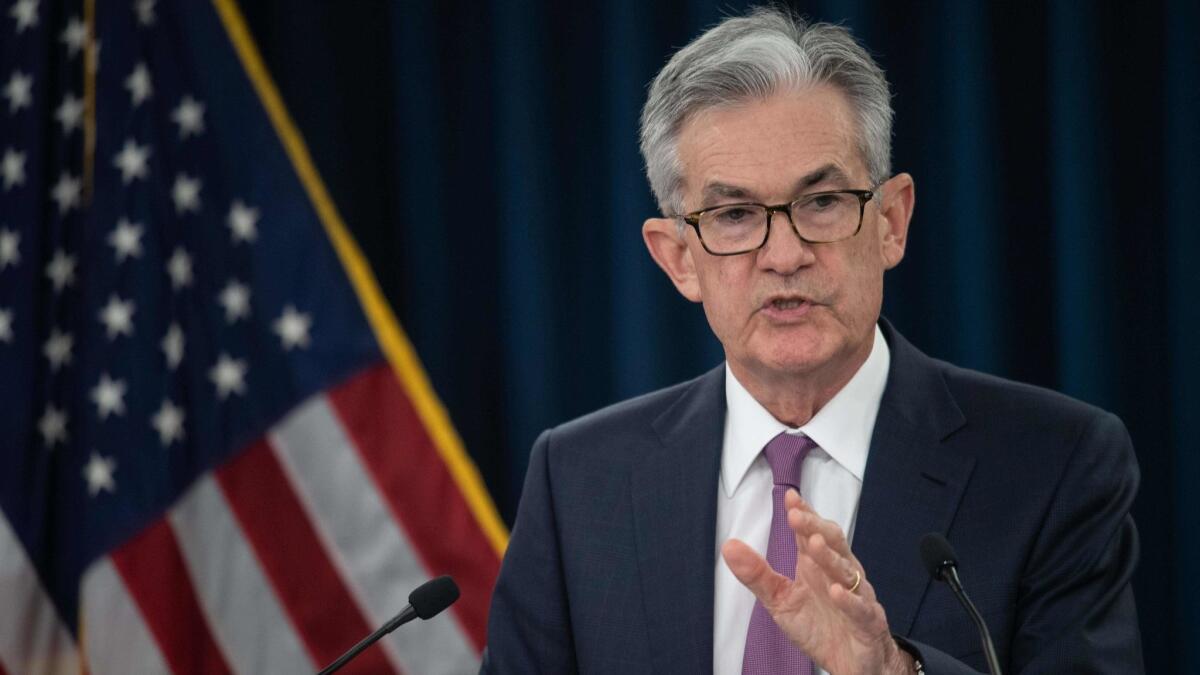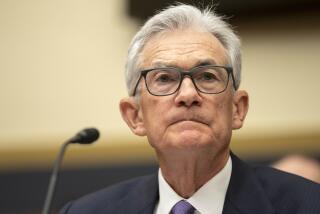By appearing to buckle to Trump on rates, is the Fed chief creating problems down the road?

In signaling that the Federal Reserve is almost certain to cut interest rates at the end of this month, Fed Chairman Jerome H. Powell may have given President Trump what he wants.
But the central bank now looks more vulnerable to criticism that it is caving to political pressures that will only grow as the election cycle heats up.
Powell, in testimony to lawmakers Wednesday, essentially argued that heightened uncertainty, from trade tensions and slowing global economic growth, along with low inflation, was enough to justify a cut in interest rates.
Historically, the Fed has lowered rates to ward off recession or when it sees substantial risks of a downturn.
The U.S. economy expanded at a nearly 3% pace last year and, although it has slowed in recent months, the Fed and most private forecasters see growth continuing at a decent rate. The latest jobs report for June showed hiring remains strong, and Trump recently agreed to a ceasefire in the trade war with China, tenuous as it may be.
For those reasons, Powell’s remarks Wednesday came as a pleasant surprise to financial markets. Stocks rose to record highs.
Lowering the rate by a quarter point later this month may help borrowers a little. The Fed’s main rate is a benchmark for credit cards, auto loans and other short-term consumer lending, but long-term rates such as mortgages already have dropped in anticipation of a Fed rate cut, meaning it’s unlikely to provide much of a boost to the housing market or the broader economy.
“We’ve already gotten 90% of the benefit; it’s already priced into the market,” said Dean Baker, senior economist at the Center for Economic and Policy Research.
Investors are expecting at least one more quarter-point rate cut after July, and some even two. Powell and his colleagues at the Fed will have their hands full managing investors’ expectations on future rate reductions, so they don’t set themselves up for a sharp fall.
“The issue that the Fed is going to run into … is just like parenting,” said Ryan Sweet, an economist at Moody’s Analytics. “They can’t bend every time the markets throw a tantrum. At some point, you’ve got to put your foot down.”
Market expectations aside, Powell’s bigger challenge is likely to come from Trump. The president has been publicly hammering Powell to lower interest rates. Trump has criticized the Fed for raising rates four times last year, and no one thinks he will be satisfied if the Fed drops its benchmark rate by a quarter point on July 31, as it’s now expected to do.
Trump and his economic team have pressed the Fed to slash rates by a full point, and Trump isn’t likely to stop jawboning the Fed in the coming months.
Some economic experts say Trump already has succeeded in getting into the heads of Fed decision makers.
“Powell does seem to be going a little bit out of his way to reverse the rate hikes made last year,” said Chris Rupkey, managing director and chief economist at MUFG Union Bank in New York. “The president’s like another active member of the Fed board in the room. I wouldn’t tell him no, would you?”
Rupkey and some other Fed watchers say Powell is moving a bit too early in readying rate cuts, especially with job growth still running very strong. Only a few months ago, the Fed’s stance on interest rates was to wait and see.
“Should they cut rates at this time? Absolutely not!” said Bernard Baumohl, chief global economist at Economic Outlook Group. “There is no economic justification to take that step now.
“For one, there is little to suggest this business cycle [is] struggling. The softness we see in some data points have little to do with economic fundamentals. The trade war with China and the havoc it has caused to global supply chain are the primary reasons those sectors have weakened.”
But other analysts argue that there’s good reason for the shift in the Fed’s posture. According to minutes from their last meeting in June, released Wednesday, Fed policymakers were feeling that the downside risks to the economy “had increased significantly over recent weeks.”
And in his testimony Wednesday to the House Financial Services Committee, Powell said that since May, crosscurrents that seemed to moderate earlier in the year “have reemerged, creating greater uncertainty.” Among other concerns, he said, business spending, trade and manufacturing activity have slowed.
“The issue really is more now on the business side where we see business confidence and business investment weakening a bit,” he told lawmakers, adding that there’s rising risk as well to consumer spending, which accounts for 70% of U.S. economic activity. “Household confidence has remained high, but over time uncertainty can cause households to hold back as well.”
Powell, sensitive to the political pressures bearing on the Fed, took pains in his prepared remarks to defend the integrity of the central bank and the basis for its policymaking.
“Congress has given us an important degree of independence so that we can effectively pursue our statutory goals based on objective analysis and data,” Powell said as he began his testimony.
Trump has reportedly considered firing Powell or demoting him, although it’s not clear whether the president has the legal authority to do so. Powell reiterated Wednesday that the law is on his side and that he intends to serve the full four-year term as Fed chair, which he assumed in February 2018.
Lawmakers on both sides of the aisle have cautioned Trump against taking steps to remove Powell as Fed leader. And on Wednesday, Democratic lawmakers sought to drive home that point.
“Mr. Chairman, if you got a call from the president today or tomorrow, and he said, ‘I’m firing you. Pack up. It’s time to go,’ what would you do?” asked Rep. Maxine Waters (D-Los Angeles), chair of the Financial Services Committee.
“Well, of course I would not do that,” Powell responded, to which Waters added, “I can’t hear you,” eliciting laughter.
But the president’s unusually persistent and heavy pressure on the Fed is anything but a laughing matter.
Alan Blinder, a Fed vice chairman in the mid-1990s, said the concern about the bank’s independence stemming from the president’s attacks was such that it could legitimately be a factor in a Fed decision not to raise rates.
Apart from the potential harm to its credibility, a more immediate risk for the Fed in cutting rates is that it could limit the central bank’s arsenal in fighting the next recession. The Fed’s main benchmark rate is less than 2.5%, low by historical standards.
In response to lawmakers’ questioning, Powell said the resumption of trade talks between the United States and China was a “constructive step” but that doesn’t really change the outlook.
“I would say that the bottom line for me is that the uncertainties around global growth and trade continue to weigh on the outlook.”







